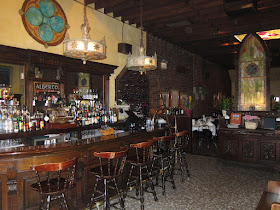Forest Hills Gardens holds a secret awaiting a new lease on life.
The back of the century-old Forest Hills Inn at 1 Station Square is home to a long-lost treasure known as the Tea Garden, of which the majority of Forest Hills is unaware.
Situated on Greenway South behind an ornate gate, a fantasy-like enclave would open in 1912 to the delight of Inn guests and residents. In 1909, Station Square was the center of social life in a planned garden community, with Grosvenor Atterbury as the Gardens’ principal architect, and Frederick Law Olmsted, Jr. as the landscape architect for public spaces and parks.
The Forest Hills Inn’s Tea Garden played host to numerous weddings, performances, and dinner dances, in addition to afternoon tea. Today, it is a shell of its former glory, and is prone to controversy between residents who wish to see it revitalized for social functions versus those who prefer restoring it as a private garden.
The Tea Garden borders the Forest Hills Inn and 20 Continental Ave, both of which are co-ops.
Nature has caused the monumental trees to flourish, but nature also cast a toll on the garden’s decorative features. The cascading fountain and pool has vanished. The “Ring For Tea” stand and rocking chairs, which were replaced with tables and umbrellas, have also vanished.
The central brick fountain is non-operational, the flagstone tiles are faded and cracked, and a gazebo bears rust. Upon first glance is a sad reality, but then the magic of what was and what could be resurrected becomes evident.
It is difficult to grasp how an integral feature could fall into abandonment and disarray, but not entirely surprising. In 1967, the Forest Hills Inn became apartments, which went co-op in the 1980s.
In 1977, it was announced that the U.S. Open would move from the nearby Forest Hills Tennis Stadium to Flushing Meadows Park. And music festivals in Forest Hills reached their peak in the 1960s.
With the change of occupancy of the Forest Hills Inn, and fewer tennis and music celebrities visiting Forest Hills, the Tea Garden was forgotten.
The July 12, 1924, edition of The Forest Hills Bulletin read, “The Tea Garden of the Forest Hills Inn is a veritable fairyland, when lighted with Japanese lanterns, with the trickling fountain heard in the background, and a new moon shining overhead. There is no more delightful place in Greater New York for one to spend the dinner hour.”
During the warmer months, every evening between 6:30 and 9 p.m. a delectable dinner was served, to the music of the Inn Trio, featuring selections such as Dvorak’s “Humoreske” and Albeniz’ “A Night In Seville.”
Ballroom dancing was featured on Saturday evenings, and the Tea Garden also hosted early performances of the Garden Players.
In a circa mid-1950s brochure uncovered in the Forest Hills Inn’s Historic Committee’s archives, the Tea Garden was then referred to as the Patio-Garden, and its glory continued. It offered “a bubbling fountain, candlelight, large umbrellas, and tall trees” with “violin strings in the spring and summer.”
Jade Eatery & Lounge holds a lease at the Forest Hills Inn, and the Tea Garden sits outside their back space.
“Many younger generations asked when the Tea Garden is opening, since they want to hold their weddings here like their ancestors,” explains manager Raymond Taylor. “We also want to hold community events, and allow the Inn and 20 Continental Ave to use the space as a common area. Jade has met some resistance from residents.”
Taylor visualizes “an authentic restoration of the garden, with possible outside funding.”
“If the fountain is approved in the plans, we would be delighted to resurrect such a tranquil piece of history,” he adds.
“Nothing can bring back the gentility of the Tea Garden,” says Martin Levinson, co-chairman of the One Station Square Historical Committee. “Instead of cellos and violins, the current era includes amplified music, liquor served to boisterous patrons, and people screaming on cell phones.”
He feels Jade’s public Tea Garden is “a security risk for those who live in the back of the Inn, since their apartments can be accessed by pranksters via terraces, trellises, air ducts, drain pipes, and roofs.” That said, Levinson does not mind a private garden.
George Hoban, co-chairman of the One Station Square Historical Committee favors re-implementing the Tea Garden, but states, "We need to communicate with our neighbors first, since its future involves them,” he says. “We are in litigation to determine who has use of the Tea Garden, which could be for Jade, our tenants, or both. We’re hopeful we will have all or partial use, since we plan to restore it."
“We are open to grants, and won’t allow work which doesn’t keep its integrity and historic character,” he adds. “Some work would be conducted off-site, to minimize on-site construction and noise. In summer 2011, we cleaned up the Tea Garden for optics purposes.”
An aesthetic and functional restoration can co-exist, with the establishment of bylaws and security measures, to appease Jade’s patrons and residents of the Forest Hills Inn and 20 Continental Ave.




































